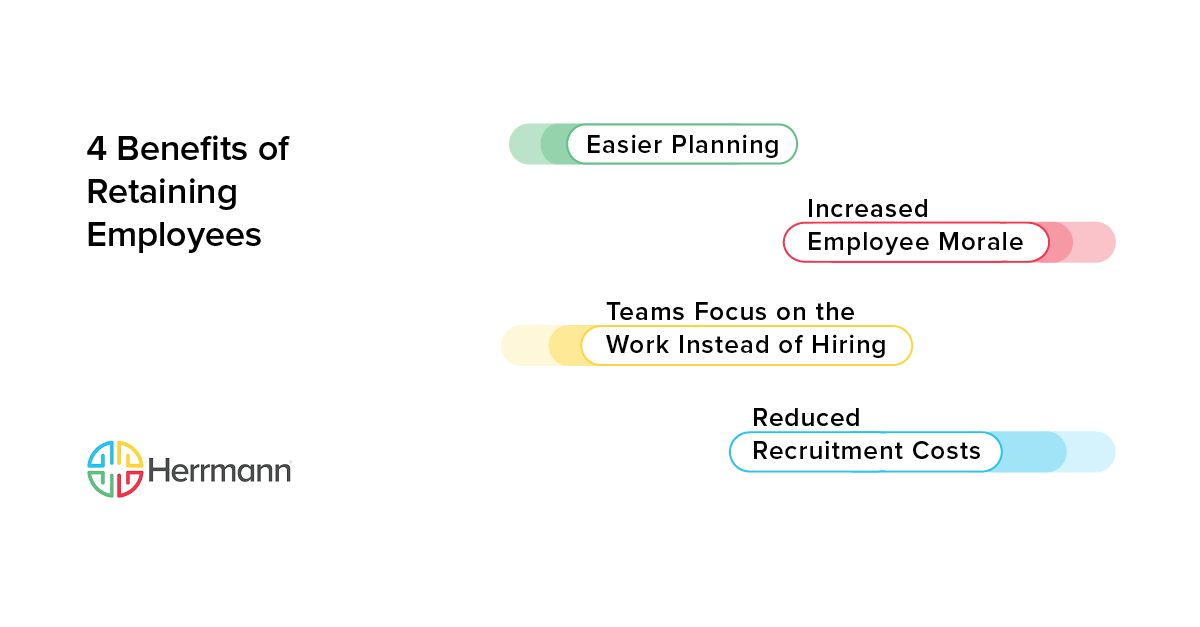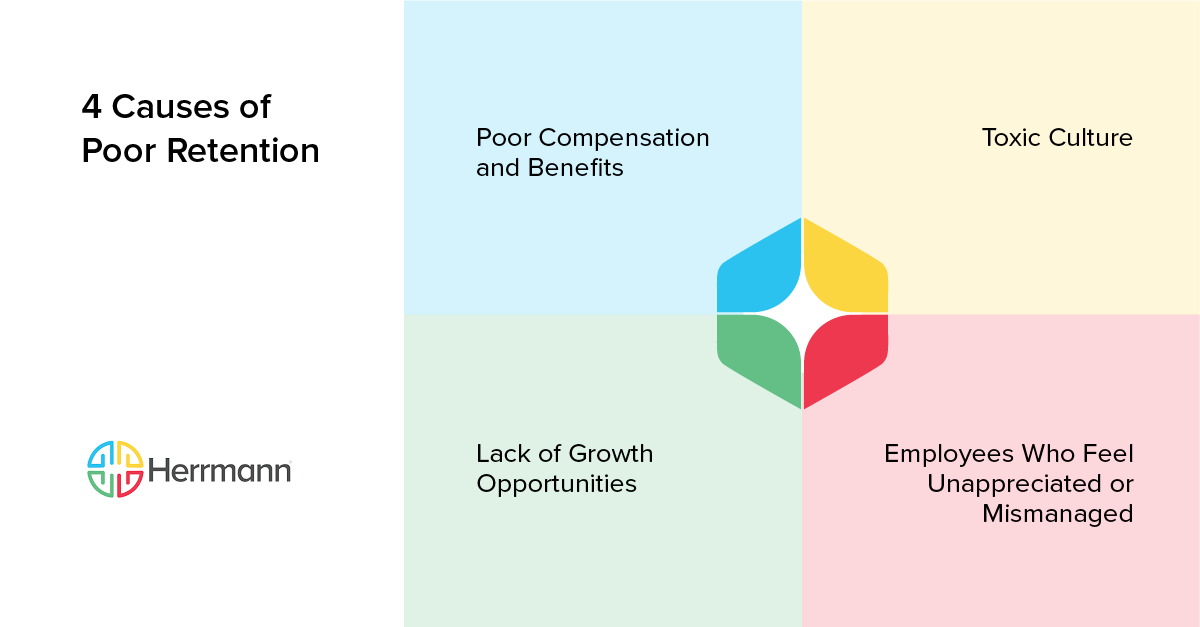What does every successful organization have in common? Great talent. And once you’ve assembled your dream team, you want to keep them around. Yet, many organizations still struggle with retaining talent. Instead of benefiting from team cohesion and institutional knowledge, they’re scrambling to cover vacancies and recruit in a competitive labor market.
While the “Great Resignation” might be over, workers are still restless. In May 2023, 50% of employees told Gallup they're open to changing jobs, proving that employee retention rates are still at risk. The good news is that retention can be addressed at every stage of the employee life cycle, starting with onboarding. Moreover, managers and leaders play a critical role in retention — creating a workplace environment that respects workers, helps them find their purpose, and encourages growth and development.
Learn more about the value of retention, how to retain your best employees, and how Whole Brain® Thinking can help you create a workplace where people want to stay.
Why Leaders Matter for Retention
Leaders at all levels play an important role in employee retention. Managers are workers’ primary go-to for direction, support, and inspiration. They’re responsible for creating a work environment that encourages growth and development. Great managers help their reports develop performance goals and give timely, constructive feedback. They set the tone for company culture and how people treat each other. Effective managers and team leaders help workers feel like they belong and can excel.
Executives, including the CEO, are a powerful factor in whether you attract and retain top talent. While managers drive day-to-day activities that affect employee engagement, executives have a bigger say in leadership and professional development opportunities. Employees are more likely to leave companies with bad leadership and few growth opportunities, according to Culture Amp data — even if they have a good manager.
Benefits of Retaining Top Talent
Retention is widely regarded as a good thing, but what are the specific benefits of employees who stick around, especially your best team members? Here are some common benefits.
Teams Focus on Innovation Instead of Hiring
Recruiting and hiring are necessary activities for businesses. Everyone needs to be replaced eventually, and growing companies need to hire because they’re scaling the business. However, the recruitment and onboarding processes take time and effort. Managers and other team members often have to split their focus — interviewing and evaluating candidates while balancing day-to-day work.
Similarly, when your team is covering gaps left by departed teammates, it’s harder for them to focus on their core work or think about innovation. But when your team is fully staffed and has worked together for a while, you can focus on higher-level work, deeper collaboration, and long-term goals and strategies.
Employee Morale Increases
Keeping the best and brightest employees on staff can help increase morale and employee satisfaction. When employees see that their company values them and rewards their hard work, they tend to be more motivated, dedicated, and loyal to their employer.
High morale also increases retention by decreasing employees’ desire to look elsewhere. Gallup’s 2023 State of the Global Workplace report found that engaged employees are 18 percentage points less likely to look for a different job than disengaged workers.
Company Reputation Improves
Retaining top talent can improve your employer brand, as you become known for having experienced employees who thrive. These workers are especially familiar with the company’s culture, products, and services, which helps them perform better and instill trust and loyalty among customers and clients.
Your employer brand also benefits when you need to hire since these tenured workers will likely recommend you to their network based on their experiences.
Recruitment Costs Go Down
Sign up to our newsletter for the latest insights
Planning Is Easier
High-performing, engaged employees are more likely to stick around — and they’re usually more productive because they understand their job assignments and how to navigate their roles.
Another benefit of a stable workforce is more consistency with company processes and planning. Because you’re not constantly introducing new workers, you have more certainty with what you can expect from your workforce in the future.

Causes of Poor Employee Retention
Employees voluntarily depart organizations for many reasons, including retirement. But many employees leave because they don’t see a future for themselves at their current job. In the worst-case scenario, they’re fleeing what they perceive to be a toxic work culture. Here are just some of the conditions that make retention difficult.
Poor Compensation and Benefits
Employees who are poorly compensated compared with peers in their industry might seek other work because they feel undervalued or because similar jobs pay better. Likewise, if a worker is struggling to get by on their current wage, they might look for other work even if you pay a reasonable amount for the job role.
Benefits are a powerful tool for retention, but a sparse benefits package can eventually lead employees to seek better opportunities. Parental leave, comprehensive health insurance, flexible work schedules, and remote work are just some of the benefits you need as part of employee retention strategies.
Lack of Growth Opportunities
Without career growth opportunities and a robust professional development plan, employees may feel bored and unchallenged in their current roles. This can lead to disengagement or cause them to look for alternative employment.
Because pay often correlates with job title, employees who don’t see a path forward in your organization also may worry that they won’t be able to increase their earning power — at least not without changing jobs.
Employees Who Feel Unappreciated or Mismanaged
Employees want to feel appreciated and valued in their work environment, especially by their manager and peers. They may look for other opportunities if they feel disrespected, unrecognized, or unfairly treated. Over half (57%) of workers who quit jobs in 2021 cited lack of respect as a factor, according to Pew Research Center data.
Even if these employees don’t quit in the near term, they can become disengaged and resentful, which are all warning signs for your team’s culture, collaboration, and productivity
Toxic Culture
While the manager-employee relationship is a factor in retention, another factor is the wider culture. One way to think about toxic cultures is as workplaces where negative behaviors, attitudes, and beliefs are accepted and even encouraged. Toxic workplaces are characterized by a lack of respect, trust, and communication among colleagues at all levels, including managers and employees.
Research published in 2022 suggests that toxicity was the strongest predictor of attrition at large companies, even when adjusted for industry.

How Leaders Can Retain Talent
Employee retention is a collaborative, ongoing effort that requires C-suite executives, HR leaders, and managers to identify causes of turnover and determine how to address them. That said, leaders carry a lot of influence in how they interact with their teams each day. Here are a few actions they can take immediately.
Create a Culture of Respect, Collaboration, and Trust
Retention is more likely in a workplace environment where employees feel comfortable communicating and collaborating with one another. Team leaders set a powerful example when they respect everyone’s humanity, encourage employees to offer differing viewpoints, and promote collaborative brainstorming to solve business challenges.
Most workers prioritize feeling valued and respected for their abilities and contributions. When they can get that recognition in their current workplace, they aren’t as active in looking for a different job.
Encourage Frequent, Open Communication
Feedback is essential for employee growth and development. Managers should have ongoing conversations about performance, goals, and career growth to ensure that employees work on the right things, improve their work, and feel supported and appreciated.
Open communication is a two-way street. Managers need to be open to employee questions about the work as well as feedback on their own performance and communication approach. As the Pew Research Center found, feeling disrespected is a key driver of turnover. But when employees have a constructive dialogue with their managers, they’re more likely to work through concerns and workplace problems rather than head for the exits.
Offer Employee Development and Growth Opportunities
Not every development opportunity needs to be a promotion. Stretch assignments, project leadership, cross-functional collaboration, and lateral moves are some ways you can help employees grow their skills and get new experiences, even if a promotion isn’t available.
Growth also includes professional development. Leaders should work with HR to determine what skills growth is best for each employee given their job role, the stage of their career, and their ultimate career goals.
Recognize and Reward Employees
Recognizing and rewarding employees for their hard work and achievements is essential to retaining talent. Leaders should make it a priority to recognize good efforts, celebrate successes, and learn from failures.
This recognition could be in the form of awards, compensation, public praise, or private correspondence, depending on the situation and the employee’s comfort level. Managers should offer recognition in smaller ways, too, such as during regular check-in conversations. Make sure they acknowledge employees’ good work and progress and not just offer negative feedback.
Compensate People Fairly and Competitively
One of the most important aspects of any job is the compensation and benefits package. Leaders should ensure that employees are being adequately compensated and given access to benefits that are competitive with other organizations.
Work with HR to understand how employees feel about their pay and benefits, what the industry standards are, and what improvements would deliver the biggest impact to employee satisfaction and retention.
How Whole Brain® Thinking Can Help Leaders Retain Talent
The Whole Brain® Thinking methodology is a powerful, science-backed and practical approach to observing and describing our thinking preferences — and the preferences of those around us. By taking the Herrmann Brain Dominance Instrument® (HBDI®) assessment, you can understand your thinking preferences in terms of Whole Brain Thinking’s four quadrants: Analytical (Blue), Practical (Green), Relational (Red), and Experimental (Yellow).
We all have access to our Whole Brain® and constantly activate many different areas simultaneously. In other words, no single thinking preference or quadrant is “right” or better than another, and everyone can access and succeed with each quadrant.
In teams and organizations, understanding everyone’s thinking preferences can bring people closer together as they embrace this cognitive diversity. Whole Brain® Thinking encourages a team culture where everyone is heard, respected, and valued — and this approach can be a powerful retention driver for leaders.
As leaders explore how to retain talent, here are a few examples where Whole Brain® Thinking can help.
Collaborative Team Meetings
Effective team meetings have a clear agenda but also allow room for participants to share ideas, ask questions, and work together on problems. But being this open in front of others requires vulnerability and trust, and that’s hard-earned.
If you’re leading a meeting where participants seem reluctant to speak up, fall back on the 4 Ps of meetings. These sample questions touch on each quadrant of the Whole Brain® Thinking model:
- Purpose (Analytical/Blue): “What are we overlooking about the purpose of this meeting?
- Process (Practical/Green): ”How can the process be improved?”
- People (Relational/Red): “What’s the effect on the people involved?”
- Possibilities (Experimental/Yellow): “What possibilities are we not exploring?”
By inviting everyone to participate and contribute their ideas, leaders help employees feel productive, valued, and heard — all of which contribute to engagement and retention.
Manager-Employee Conversations
Conversations between managers and employees are a perfect place for leaders to apply Whole Brain® Thinking, particularly in stretching themselves to consider thinking preferences that are less natural for them.
For example, a manager might be highly analytical (Blue) and practical (Green). This helps them do well with organizing their team’s activities, identifying business-relevant goals, and measuring outcomes. However, they might find themselves not always thinking first about how their plans and demands affect the people working for them. Or they might miss opportunities for experimental thinking while focusing on deadlines and to-dos.
This manager can use employee conversations to re-center themselves and understand how their team members feel about the work and what ideas they might have for further improvements. Meanwhile, the employee can use this opportunity to learn from their manager about the business.
Recognition and Feedback
Employees can have a variety of reactions to recognition and feedback depending on their life experiences and thinking preferences. This is another area where teams that have taken the HBDI® can use Whole Brain® Thinking to better understand each other and form tighter bonds.
For example, an employee might be sensitive to criticism (Relational) because they were poorly treated in a past job. But they might be open to feedback when presented as a teaching opportunity. Managers can frame feedback as a process to learn (Green) rather than a condemnation of their aptitude.
Another example is recognition. Some employees are highly motivated by measurable goals (Analytical) and often want monetary recognition. Other employees might enjoy a bonus, but they’d rather be recognized for their unconventional ideas (Experimental) and be given room to pursue those avenues. When leaders can identify what motivates their employees, they are a step closer to helping them stay with the employer rather than chase that feeling elsewhere.
Be the Leader Who Retains Top Talent
Retaining talent is on every company’s minds as quit rates stay relatively high and labor markets remain tight, and an aging workforce suggests this could be a lasting trend. High turnover can quickly shift from an inconvenience to an existential threat to the business.
Leaders have many options for retaining employees. Start by treating people with respect, compensating them fairly, and giving them growth opportunities. Apply Whole Brain® Thinking to your interactions and processes, helping employees see their best chance for professional success and connection with your organization.
Turn cognitive diversity into business results with our inclusive leadership playbook.












